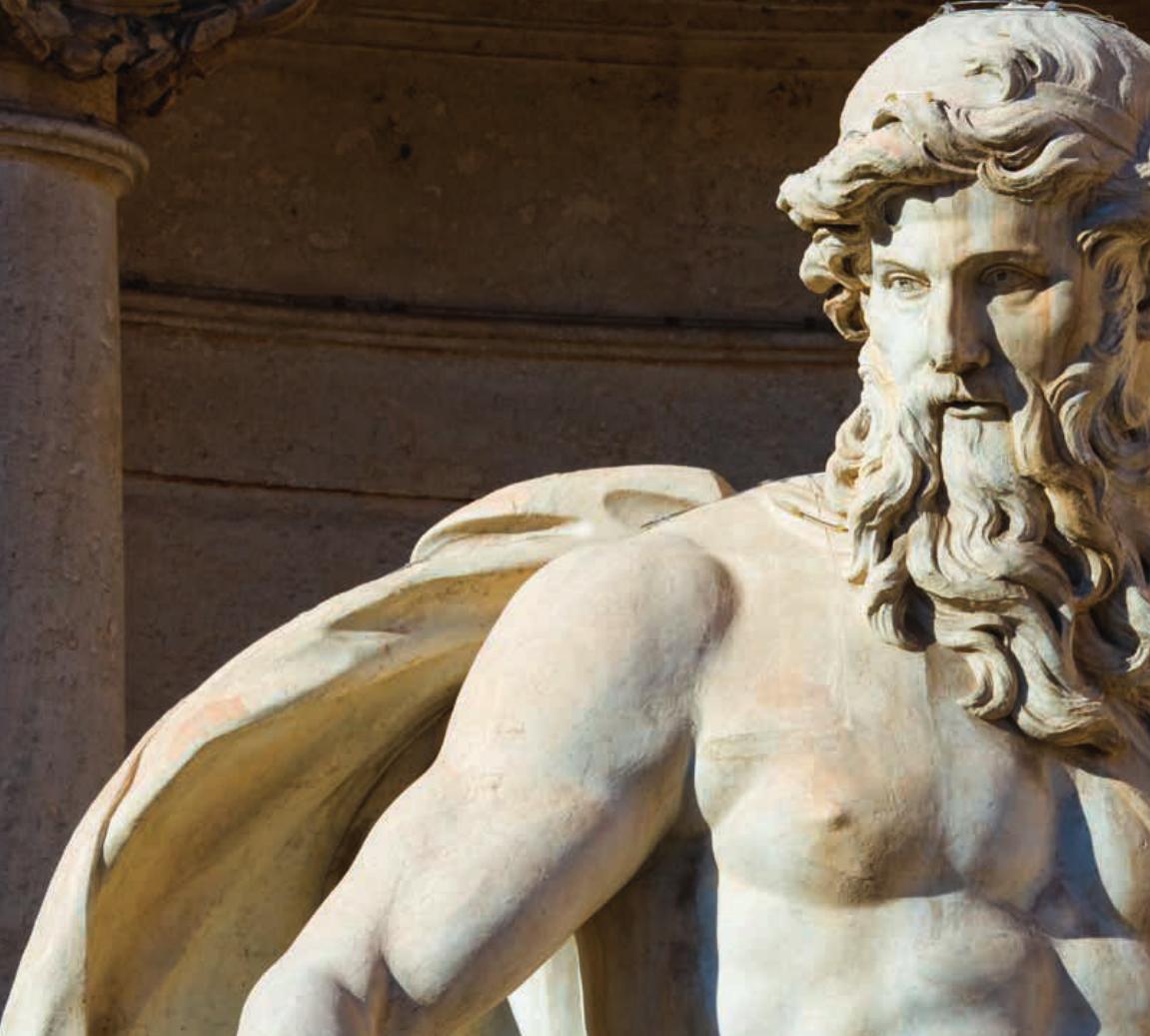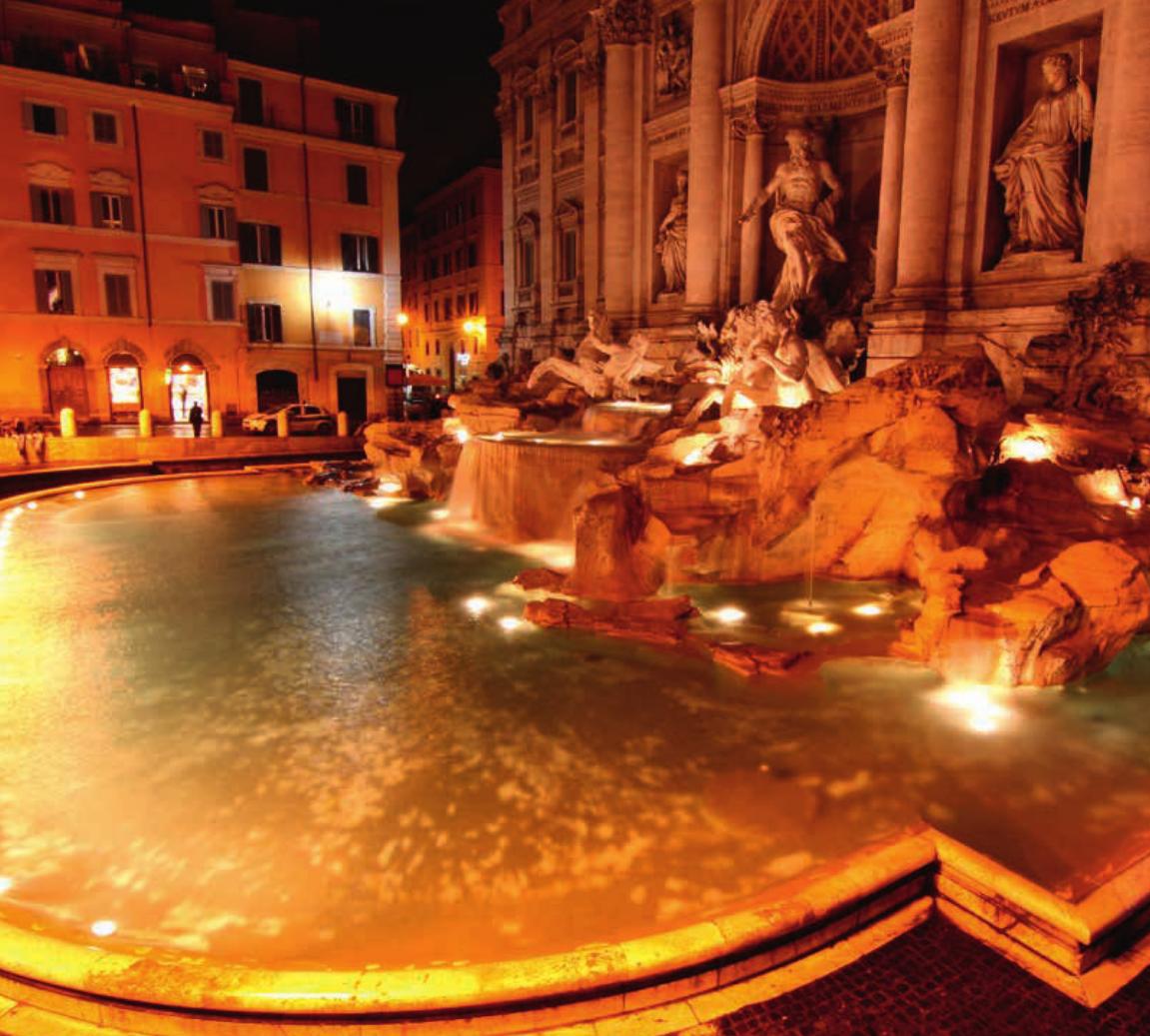Page is loading ...

TreviFountain
RomeItaly
FontanadiTrevi
RomaItalia
Booklet available in English on
Heft in deutscher Sprache erhältlich auf
Livret disponible en français sur
Folleto disponible en español en
Folheto disponível em português em
A füzet magyarul ezen a honlapon olvasható
Libretto disponibile in italiano su: LEGO.com/Architecture

2
©Shutterstock
TreviFountain
RomeItaly
The Trevi Fountain (Fontana di Trevi) is the
most famous and arguably the most beautiful
fountain in Rome. This impressive Baroque-
styled monument was completed in 1762 and
still dominates the small Trevi square located
in the city’s Quirinale district.

3

4
History
The imposing fountain sits at the junction of
three roads, or tre vie, which many believe
gave the fountain its name, and marks the
terminal point of one of the original aqueducts
that supplied water to ancient Rome. Built by
Marcu Vipsanius Agrippa in 19 BC, the Aqua
Virgo aqueduct was over 13 miles (21 km) long
and even then had a fountain at its terminus.
The aqueduct and fountain served Rome for
over 400 years, but after the invasion of the
Goths in AD 537, the aqueduct was cut off
and the final portion abandoned, forcing the
medieval Romans to draw water from wells
and the River Tiber. It would be over 1,000
years, and the advent of the Early Renaissance
period, before a fountain would again stand in
the location we know today.

5
©Shutterstock

6
Many smaller fountains were constructed
between 1400 and 1700, almost all of them at
the behest of the reigning pope. It was also
Pope Clement XII who organized a competition
in 1730 to build a more dramatic fountain.
Many of the most renowned architects of the
day entered the competition, which architect
Nicola Salvi eventually won.
With a budget of 17,647 Scudo (the Papal
State’s currency), work began in 1732.
Unfortunately, neither Clement XII nor Salvi
would live to see the work completed. It was
Pietro Bracci who, under the guardianship of
Clement XIII, would complete the project. The
magnificent fountain that we know today was
officially opened on Sunday, May 22, 1762.
The central theme of this impressive fountain is
the Taming of the Waters. In a mix of water and
rockwork, Tritons guide Oceanus’ shell chariot,
taming the horses, or hippocampi, of the sea.
A triumphal arch with three niches holds the
fountain’s main statues. The center niche
frames Oceanus and includes freestanding
columns for maximal light and shade. In the
niches flanking Oceanus, Abundance spills
water from her urn and Salubrity holds a cup
from which a snake drinks. Above, bas-reliefs
illustrate the Roman origin of the aqueducts.
The 86 ft. (26.3 m) tall and 161.3 ft. (49.15 m)
wide fountain is superimposed on a backdrop
of the elegant Palazzo Poli. The palace was
given a new facade to match the fountain and
today houses the National Institute of Graphic
Art.
Design & Construction

7
©Shutterstock

8
The Trevi Fountain Today
The Trevi Fountain has become an iconic
symbol of Rome and remains one of the city’s
most popular tourist attractions. A traditional
legend holds that if visitors throw a coin into
the fountain, they are ensured a return to
Rome. It is estimated that 3,000 euros are
thrown into the fountain each day.
The fountain has provided a backdrop for many
classic movies, including Hollywood’s 1954
romantic comedy, Three Coins in a Fountain,
and Federico Fellini’s famous 1960 La Dolce
Vita. Part of the fountain is also replicated at
the Italy Pavilion at Epcot in Walt Disney World
in the US.
The fountain was refurbished in 1998; the
stonework was scrubbed and all cracks and
other areas of deterioration were repaired by
skilled artisans, and the fountain was equipped
with recirculating pumps.
In January 2013, it was announced that
the Italian fashion company Fendi would
sponsor a 20-month, € 2.2 million restoration
of the fountain; it will be the most thorough
restoration in the fountain’s history.

9
© Shutterstock

10
© Shutterstock
The Architects
Little of Nicola Salvi’s (1697–1751) work beyond
the Trevi Fountain remains today and relatively
little is known of the architect himself. He was
admitted to the Roman Academy of Arcadia
in 1717 and only became an architect after
studying mathematics and philosophy. His
friend and colleague, the sculptor Pietro
Bracci (1700–1773), would eventually go on to
complete the fountain. Bracci’s most famous
piece of work, the statue of Oceanus, forms
the centerpiece of the fountain.
Facts about
the Trevi Fountain
Location: .................................. Rome, Italy
People: ...................................... Pope Clement XII,
Pope Clement XIII,
Nicola Salvi,
Pietro Bracci
Construction Period: ....... 1732 to 1762
Measurements: ................... Height 86 ft. (26.3 m)
Width 161.3 ft. (49.15 m)
Materials: ................................. Travertine stone

11
© Shutterstock

12
FontanadiTrevi
RomaItalia
La Fontana di Trevi è la più famosa e forse la
più bella fontana di Roma. Questo imponente
monumento in stile barocco, completato nel
1762, domina ancora oggi la piccola piazza di
Trevi nel quartiere del Quirinale.
©Shutterstock

13

14
Storia
L'imponente fontana si trova all'incrocio di
tre strade, o trivium, dal quale probabilmente
il monumento ha preso il suo nome, e il
punto terminale di uno degli acquedotti che
rifornivano di acqua l'antica Roma. Costruito
da Marco Vipsanio Agrippa nel 19 a.C.,
l'acquedotto Aqua Virgo misurava oltre 20 km
di lunghezza e anche a quel tempo la fontana
era il suo punto terminale.
L'acquedotto e la fontana hanno servito Roma
per più di 400 anni, ma dopo l'invasione dei
Goti nel 537 d.C., l'acquedotto fu danneggiato
e la sezione finale abbandonata, costringendo
i romani dei tempi medievali ad attingere
l'acqua dai pozzi e dal fiume Tevere. Sarebbero
trascorsi più di 1.000 anni, all'inizio dell'epoca
rinascimentale, prima che la fontana fosse
restaurata nell'esatta posizione odierna.

15
©Shutterstock

16
Molte piccole fontane furono costruite tra il
1400 e il 1700 e quasi tutte per volere del papa
regnante. Nel 1730, Papa Clemente XII bandì un
concorso per la costruzione di una importante
mostra d'acqua. Molti dei più noti architetti
dell'epoca parteciparono al concorso, che alla
fine fu assegnato a Nicola Salvi.
Con un finanziamento di 17.647 scudi (la moneta
dello Stato Pontificio), i lavori iniziarono nel 1732.
Sfortunatamente, né Clemente XII né Salvi
avrebbero visto la conclusione dell'opera. Fu
Pietro Bracci che, sotto la tutela di Clemente XIII,
avrebbe completato il progetto. La magnifica
fontana che conosciamo oggi fu inaugurata
ufficialmente il 22 maggio 1762, una domenica.
Il tema centrale è quello del mare. La scena
principale è dominata da una scogliera rocciosa,
su cui si trova il cocchio a forma di conchiglia
di Oceano, trainato da due cavalli alati, a sua
volta guidati da tritoni. Un arco trionfale, con
tre nicchie, ospita le statue principali della
fontana. La nicchia centrale incornicia Oceano
e include quattro grandi colonne individuali
per la massima illuminazione e ombreggiatura.
Nelle nicchie laterali, troviamo la statua
dell'Abbondanza, intenta a versare acqua dalla
sua urna, e quella della Salubrità, con in mano
una coppa alla quale si disseta un serpente.
Sopra le statue, alcuni bassorilievi illustrano
l'origine romana degli acquedotti.
Alle spalle della fontana, alta 26,3 m e larga 49,15
m, si erge l'elegante Palazzo Poli. Una nuova
facciata fu realizzata per il palazzo per abbinarla
allo stile architettonico della fontana; attualmente
ospita l'Istituto Nazionale per la Grafica.
Progettazione e costruzione

17
©Shutterstock

18
La Fontana di Trevi oggi
La Fontana di Trevi è diventata un simbolo
iconico di Roma ed è una delle più popolari
attrazioni turistiche della città. Una leggenda
vuole che i visitatori che lanciano una moneta
nella fontana si propizieranno un futuro ritorno
a Roma. È stato calcolato che monetine per un
valore di circa 3.000 euro siano gettate ogni
giorno nella fontana.
La fontana ha fatto da sfondo a numerosi film
classici, tra cui la commedia romantica di
Hollywood del 1954, Tre soldi nella fontana, e
ovviamente La Dolce Vita di Federico Fellini,
del 1960. Parte della fontana è stata anche
replicata al Padiglione Italia del Walt Disney
World, a Epcot, negli Stati Uniti.
La fontana è stata restaurata nel 1998; le
sezioni in pietra sono state pulite e tutte
le crepe e altre aree di degrado sono state
riparate da esperti artigiani; la fontana è stata
infine dotata di pompe di ricircolo.
Nel gennaio del 2013, è stato annunciato
che Fendi, la famosa casa di moda italiana,
avrebbe sponsorizzato un progetto di restauro
della durata di 20 mesi e del valore di € 2,2
milioni; si tratterà del restauro più meticoloso
della storia della fontana.

19
© Shutterstock

20
© Shutterstock
Gli architetti
Poche tracce dell'opera di Nicola Salvi
(1697–1751) – oltre naturalmente alla Fontana
di Trevi – rimangono oggigiorno e anche le
notizie sull'architetto scarseggiano. Ammesso
all'Accademia dell'Arcadia romana nel 1717, si
dedicò all'architettura solo dopo aver studiato
matematica e filosofia. Fu il suo amico e
collega, lo scultore Pietro Bracci (1700-1773),
a completare la fontana dopo la sua morte.
L'opera più famosa di Bracci, la statua di
Oceano, è il fulcro della Fontana di Trevi.
Alcuni dati sulla
Fontana di Trevi
Ubicazione: ............................ Roma, Italia
Personaggi: ............................ Papa Clemente XII,
Papa Clemente XIII,
Nicola Salvi,
Pietro Bracci
Periodo di costruzione: 1732-1762
Dimensioni: ............................ Altezza 26,3 m
Larghezza 49,15 m
Materiali: ................................... Travertino
/
